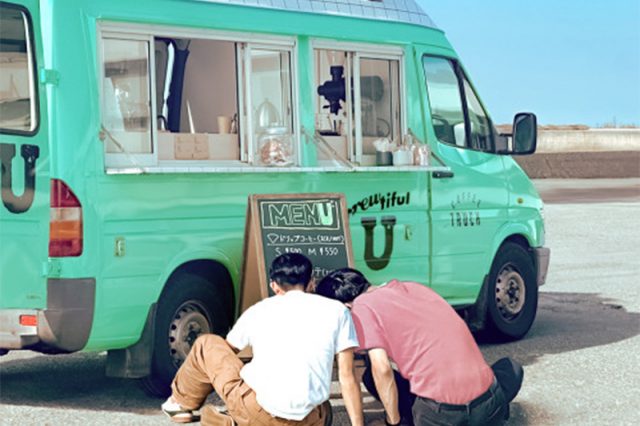Netflix’s new reality show The Boyfriend has been making waves and starting conversations both inside and outside Japan as viewers follow the story of nine gay and bisexual male housemates who live and work together.
It has a fairly recognizable format. As well as living together, castmates work in a coffee van. They are, according to Netflix, looking for love and friendship. In order to bring them together, as well as working in pairs in the van, they have to complete tasks, including challenges and games that involve partnering off.
Critics and commentators have hailed the show as a new direction for Japanese Netflix programming. However, in many ways The Boyfriend hews close to an established model of program development that emerged from an early crisis in Netflix’s initial attempts to launch in Japan.
The streamer’s launch in 2015 was met with a mixed reception from Japanese television and on-demand streaming viewers. Initially, uptake in Japan was fairly slow. Japanese Netflix users did not appear enthused about the site’s particular USP – high-quality English language “Netflix original” shows such as House of Cards and Orange is the New Black.
By the end of its first year, Netflix Japan announced a plan to increase Japanese content – especially Japanese Netflix originals.
This decision may have been an attempt to improve Netflix’s popular image in Japan, particularly in relation to criticism in the Japanese press which cast Netflix as a cultural imperialist vehicle. These critics called it a “black ship” (kurofune) forcing US media content on Japan in the same way that Commodore Matthew Perry’s black ships forced Japan into trade relationships after a long period of closed borders in 1854.
Netflix’s Japanese content grew and thrived despite criticism and in February 2018 overtook Netflix American content in Japan. A number of Japanese language television shows have also found audiences around the world, expanding overseas interest in Japanese media content from the pre-established fan bases of devoted anime fans, arthouse and “Asian extreme” cinephiles.
Opening new doors with ‘Terrace House’
Terrace House, a gentle reality show featuring mixed-gender castmates living together in a luxury apartment was the first Japanese Netflix program to find widespread viewership outside Japan. The show originated on Fuji Television in 2012 and was re-launched on Netflix in 2015 under the spin-off title “Opening New Doors.”
The first season did indeed open new doors. The show found new audiences in the US, UK and around the world, and led to a partnership between Netflix and Fuji. It also introduced international audiences to particular aspects of Japanese television programming such as the role of television personalities or “tarento” (which translates to “talent”) – these are multifaceted entertainers who can sing, act, talk and host and appear on all sorts of shows.
Terrace House regularly cuts away from footage of housemates interacting to a staged living room with five tarento. These “tarento” comment on the preceding footage, speculating on how key storylines might develop and praising or criticising the housemates.
In the past there have been concerns that tarento criticism may have played a role in online harassment of reality television show participants with tragic consequences, when one house member took her own life. Despite these concerns, The Boyfriend borrows the same format. It even includes one of the original Terrace House tarento, comedian and actor Yoshimi Tokui. Terrace House producer Dai Ota is executive producer on The Boyfriend. But there are new voices, such as Durian Lollobrigida, a popular drag queen who acts as “translator” for the heterosexual tarento.
While these borrowings may be familiar to viewers of Terrace House, The Boyfriend also draws from a genre with a smaller audience outside Japan.
‘Boys Love’ for girls
“Boy’s love”, often shortened to “BL” and also known as “yaoi”, refers to manga, anime, and increasingly live-action stories, about male-male romance that draw a broad female audience in Japan and East Asia. The opening animated credit sequence leans heavily on BL aesthetics. The frequent discussion of “types” both among the housemates and the tarento references a dominant trope in BL narratives that matches characters according to physical attributes and style, or “type.”
The cast members of The Boyfriend appear to be aware of this connection. Discussing how to name the coffee van that the housemates will work from over the series, they joke that the name should somehow incorporate the letters B and L, so that “people who know” will “get it.”
While the show borrows from some well-established genres to access known fan bases, bringing reality television and BL together is an innovative idea.
The inclusion of cast members with Korean, Taiwanese and Brazilian heritage also suggests a pioneering approach to casting a show marked clearly as “Japanese”. This casting decision implicitly rejects the pervasive view of Japan as racially homogenous and culturally unique (known as nihonjinron) which characterises many popular accounts of the country both inside Japan and outside.
The focus on same-sex relationships in a country where marriage rights have not been extended equally to the LGBTQ+ population can clearly start an important conversation at a time when popular opinion is shifting in favour of change.
Whether such fundamental changes can be achieved through entertainment media remains debatable, but while we wait, The Boyfriend is certainly an enjoyable way to pass the time. Stylish living quarters and housemates, delicious meals cooked by the resident chef, and a tendency to shoot intimate confessional conversations on the beach at “magic hour” ensure that the show is a visual delight with heartwarming themes.![]()
Jennifer Coates, Professor of Japanese Studies, University of Sheffield. This article is republished from The Conversation under a Creative Commons license. Read the original article.










